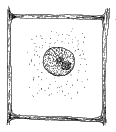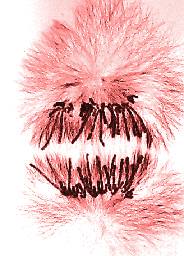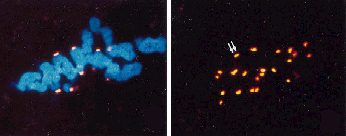
|
Karyokinesis and Cytokinesis - Mitosis
|
Normally cytokinesis and karyokinesis (divisions of cell and
nucleus) are coupled. Exceptions do exist, but they will be discussed
elsewhere. The process of the division of
the nucleus in plant cells was elucidated by E.
STRASBURGER and published in his fundamental work "Zellbildung
und Zellteilung" (Cell Formation And Cell Division) in 1875. Already
in 1884 the results had been part of his 'Kleines botanisches
Praktikum' (A Short Course on Botany) and since 1894 they were an
established part of his "Lehrbuch der Botanik" (A Textbook on
Botany). In the 4th edition the division of the nucleus is described
as follows:
" Except for special and very limited cases plant cell nuclei propagate by the so-called mitotic or indirect division. The process is also called karyokinesis (today usually mitosis). It is a rather complicated process that seems to be necessary to distribute the substance of the mother nucleus evenly on both daughter nuclei."
At first STRASBURGER did work with material that had been fixed with alcohol. But in 1879 A. LUNDSTRÖM was able to investigate the mitosis of a living specimen, the anthers of Tradescantia. Modern microscopic techniques, especially phase contrast and interference contrast microscopy allow today to make the process of the division of the nucleus visible in a lot of cell types.
Impressing educational films for schools on this process exist, so
that every student of biology should actually be familiar with it
even before the beginning of his study.
|
Confocal laser scanning micrograph of an anaphase onion
root tip cell showing immunocytochemical labelling of the
Golgi apparatus and plasma membrane
|
STRASBURGER's possibilities were much humbler. Even though he did
notice that the nuclei stretch before or at the beginning of mitosis
and take on a spindly shape. Longitudinal structures become visible.
He saw states, where they shortened and finally appeared as compact
little rods. In 1888 they were termed
chromosomes (Greek:
chroma=colour; soma=body) by WALDEYER, because they
were particularly well stained with a certain nuclear dye.
The state at the beginning of mitosis, where the chromosomes
become visible was termed
prophase after a suggestion of
STRASBURGER. The German anatomist W. FLEMMING recognized in 1880 that
the chromosomes of the prophase are characterized by a longitudinal
gap.
After the prophase the chromosomes are arranged
at the plane of cell division forming the
equatorial plane. This state is
called the metaphase. Both chromosome
halves (the chromatids) are
clearly recognizable. Consequently they separate in opposite
directions to form the two daughter nuclei. The phase of separation
is termed anaphase, the formation of the
daughter nuclei telophase.

Other processes are also involved. While the chromatin becomes
shorter, disentangles and separates into single chromosomes, fibrous
looking aggregates form in the plasma that strech from pole to pole.
They are called spindle fibres
and the whole structure has the name mitotic
spindle. The spindle is composed of undisrupted fibres
(they are bundles or aggregates of overlapping microtubules)
that stretch from pole to pole (polar
microtubules) and of other fibres that connect the pole
with a chromosome (kinetochore
microtubules). The separation of the chromatids is caused
by the contraction of the kinetochore microtubules. The kinetochore
microtubule is attached to a certain area of the chromosome, the
kinetochore, that each chromosome
develops during late prophase . Depending on its location the typical
V-, L-, U- or I-shaped structures of the anaphase form.

|

It is known today that the fibres contain tubuline,
the subunit of microtubules. It can be stained selectively with
fluorescence-tagged antibodies.
The spindle fibres are in fact bundles of
microtubules. During late anaphase the new cell wall becomes visible
in the equatorial plane. The wall
formation is completed during telophase.
In contrast animal cells divide by constriction of the mother cell. The decisive importance of mitosis in both cases is the qualitatively and quantitatively exact distribution of the hereditary material, whereby the longitudinal splaying represents the most important point. Each daughter cell does accordingly inherit one half of a chromosome, a chromatid. The number of chromosomes is usually specific for a certain species. This discovery was also made by E. STRASBURGER and the zoologist RABL from Prague showed that it applies to animal cells, too. Exceptions are caused, when single chromosomes stick together at their ends, whereby the number of chromosomes changes. Such changes together with the simultaneous genetic changes proved finally that the theory of chromosomes was right.
|
|